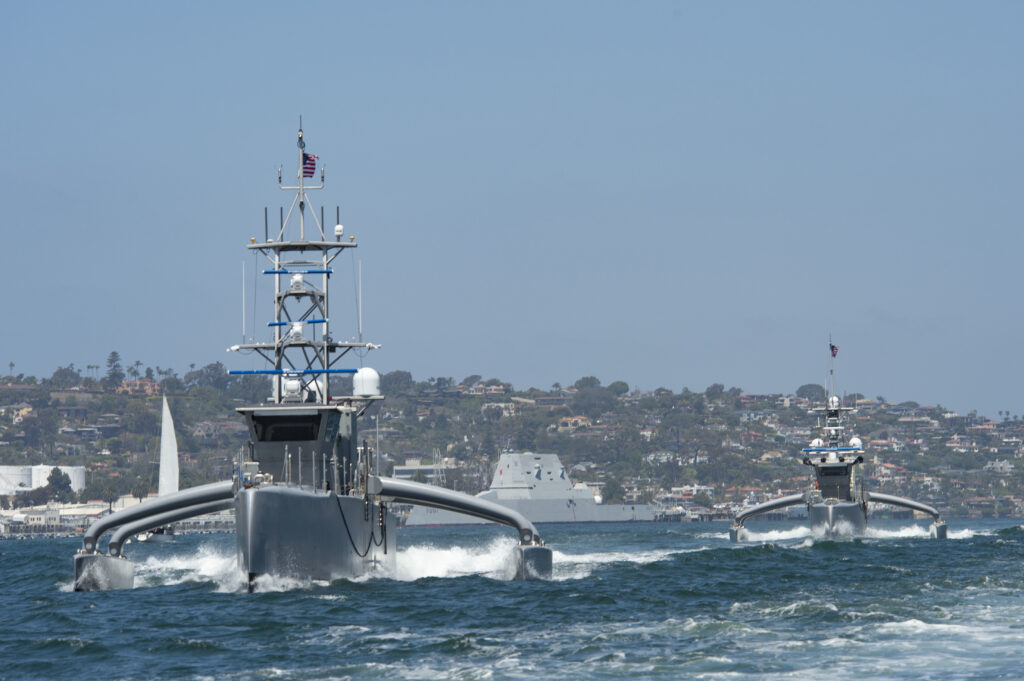
The unmanned ships Seahawk, front, and Sea Hunter launch for the Pacific Fleet’s Unmanned Systems Integrated Battle Problem 21
WASHINGTON: A fleet of destroyers, unmanned ships and drones are working off the coast of California in the Navy’s largest attempt to understand how to develop a planned autonomous fleet of the future.
One of the most anticipated aspects of the exercise will be to conduct live fire launches from one of the destroyers at a target identified by a drone from over the horizon, proving out at least an initial capability to use unmanned ships as a surveillance asset.
“We are going to do a live-fire offensive exercise,” Rear Adm. Jim Aiken, Carrier Strike Group 3 commander and one of the exercise’s leaders told reporters Tuesday. “We are going to use the unmanned surface, unmanned air, and manned air and surface to provide a targeting solution,” that will feed information back to a ship or submarine that does the shooting.
Aiken would not discuss the type of missile or which ship would fire the potentially killing blow, though the Littoral Combat Ship USS Coronado is equipped with a Harpoon missile launcher. The LCS Fort Worth is also participating, along with four Arleigh Burke destroyers and the Zumwalt-class USS Michael Monsoor, all of which can launch a variety of missiles from their vertical launch tubes. The USS Hampton attack submarine, which will be prowling under the surface, is also a potential shooter.
The amphibious transport dock USS Anchorage is also taking part in the exercise, with P-8A Poseidon and EA-18 Growler electronic warfare aircraft flying overhead.
When pressed about which platform would do the shooting, Aiken said “we want to keep options open. I think we want to be able to look at different ways to produce results [with] the number of unmanned systems that we have.”
The exercise will include the Super Swarm project, a secretive Office of Naval Research effort to operate swarms of small drones, and the MQ-8B Fire Scout UAV launched from a Littoral Combat Ship, as well as the MQ-9 Sea Guardian UAV. The Fire Scout and Sea Guardian will integrate with both Navy and Marine Corps units.
That expected reliance on a variety of systems that are in various states of development, as opposed to developing specific ships that have specific capabilities bolted on, is a change from the way the Navy has developed new classes of ships in the past.
The service appears to have learned some lessons from it’s recent multi-billion embarrassments in building the LCS and Zumwalt destroyers, which they’re now working to figure out where and how to fit them into the fleet after much of their initial promise faded away.
The effort to build new large and medium unmanned ships isn’t so much focused on the type of hull that surveillance and strike capabilities will be bolted on to, but rather leadership is looking to develop those capabilities and then find ships that can accommodate them.
“We want to move from just systems to capabilities,” Aiken said. When those capabilities are identified and tested, that will “give us an advantage where we now are able to take that information and we’re able to move it at speed.”
This falls in line with the path forward Chief of Naval Operations Adm. Michael Gilday outlined earlier this month, when he said the current exercise would “further inform our understanding of where we need to go with unmanned. Particularly the capabilities and then eventually the numbers,” of new ships that would require.
“It’s easy to get seduced by the numbers, and we shouldn’t,” Gilday said, breaking somewhat from his predecessors’ sole focus on building a 355-ship fleet. “What we really need to be focused on is capabilities, and particularly what capabilities the Navy can close for the joint force,” he added. The goal is to find “capabilities that then translate into platforms.”
That approach is likely partially based on previous issues with getting systems to work on ship classes that were already being built, but it’s also a realization that with flat budgets going forward, there simply might not be the money available to expand the fleet the way the Navy has said it wants to.






















